
The index page for the 1954 French flap section of this website is here.
Reference for this case: 7-Jan-54-Fécamp.
Please cite this reference in any correspondence with me regarding this case.
The press for October 8, 1954, had widely reported the explosion of a fireball in the sky which on January 7, 1954 between 4:00 and 5:15 a.m. had woken residents of Dieppe. The newspapers indicated that the semaphore of Dieppe had contacted that of Fécamp, where the fireball was confirmed.
It was not claimed to be a "flying saucer", it was said that the Institut d'Astrophysique de Paris thought it was a meteor.
The national newspaper Paris-Presse for January 9, 1954, explained that the ball of fire which had been seen in the sky of Dieppe and other places, including in Fécamp by the semaphore operators, was perhaps a "flying saucer" in popular opinion, but observers from the Institut d'Astrophysique de Paris thought it was a fireball.
I did not find any source of the time or later source giving a description of the observation from Fécamp or specified the hour of the observation from Fécamp.
However, in his 1954 book, ufologist Jimmy Guieu estimated - without quoting Fécamp as one of the observation places - that it was an interplanetary craft: believing that the hours given by the various witnesses at the various places were of chronometric precision, he claimed that the "fireball" had stopped for a while and started again. In 1954, in his book "Lueur sur les Soucoupes Volantes", ufologist Aimé Michel cited Fécamp as one of the places of observation, a few seconds after 04:27, and would quote, perhaps without believing it, the explanation by a meteor by the spokesman of the Institute of Astrophysics of Paris.
Others would cite the incident, as if it were unexplained, in their UFO literature, to this day.
[Ref. ofe1:] "OUEST FRANCE" NEWSPAPER:
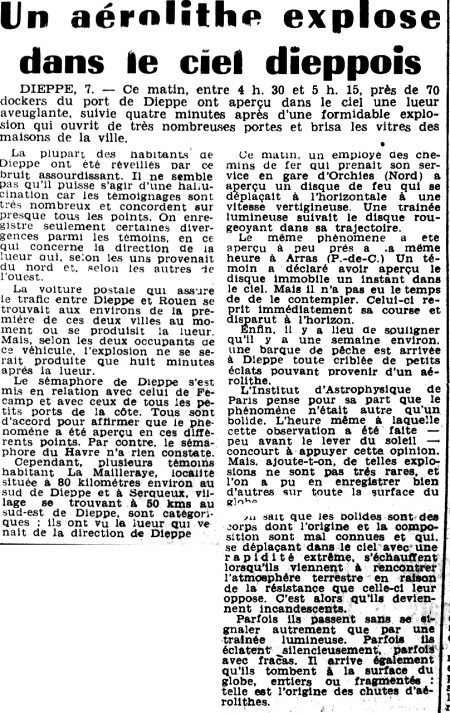
|
DIEPPE, 7. - This morning, between 4:30 a.m. and 5:15 a.m., nearly 70 dockers of the Dieppe harbor saw in the sky a blinding gleam [sic], followed four minutes later of a tremendous explosion that opened a large number of doors and broke the windows of the houses in the city.
Most of the Dieppe residents were awakened by the deafening noise. It does not seem that this may be an hallucination because testimonies are numerous and agree on almost all points. Only some discrepancies among the witnesses are recorded in regard to the direction of the light; which according to some came from the north, and for some others from the west.
The mail car that ensures the traffic between Dieppe and Rouen was around the first of these two towns when the light occurred. But according to the two occupants of the vehicle, the explosion would have occurred eight minutes after the glow.
The Dieppe semaphore contacted that of Fécamp and those of all the small harbors along the coast. All agree to say that the phenomenon was seen in these points. However, the semaphore of Le Havre did not notice anything.
However, several witnesses from the Mailleraye locality at about 80 kilometers south of Dieppe, are adamant that they saw the glow coming from the Dieppe area.
This morning, a railways employee took his duty at the station of Orchies (Nord) and saw a disc of fire that moved horizontally at a dizzying speed. A luminous trail followed the glowing disc in its path.
The same phenomenon was seen at about the same time in Arras (Pas-de-Calais). A witness said he saw the disc motionless in the sky for a moment. But he did not have time to contemplate it. It immediately resumed its course and disappeared over the horizon.
Finally, it should be emphasized that about a week ago, a fishing boat arrived at Dieppe all riddled with small holes that might have been caused by a fireball.
The Institute of Astrophysics of Paris believes, however, that the phenomenon was no other than a meteor. The very hour that made this observation - shortly before sunrise - concurs to support this opinion [!]. But, they add, such explosions are not very rare, and one was able to record many others of them across the globe.
We know that the fireballs are bodies whose origin and composition are unclear and that, moving in the sky extremely quickly, warm up when they come to meet the Earth's atmosphere because of the resistance thereof. Then they become incandescent.
Sometimes they go without other signs than a luminous trail. Sometimes they break silently, sometimes noisily. It also happens that they fall to the earth's surface, whole or fragmented: this is the origin of fireballs falls.
[Ref. lpl1:] NEWSPAPER "LE PROVENCAL":
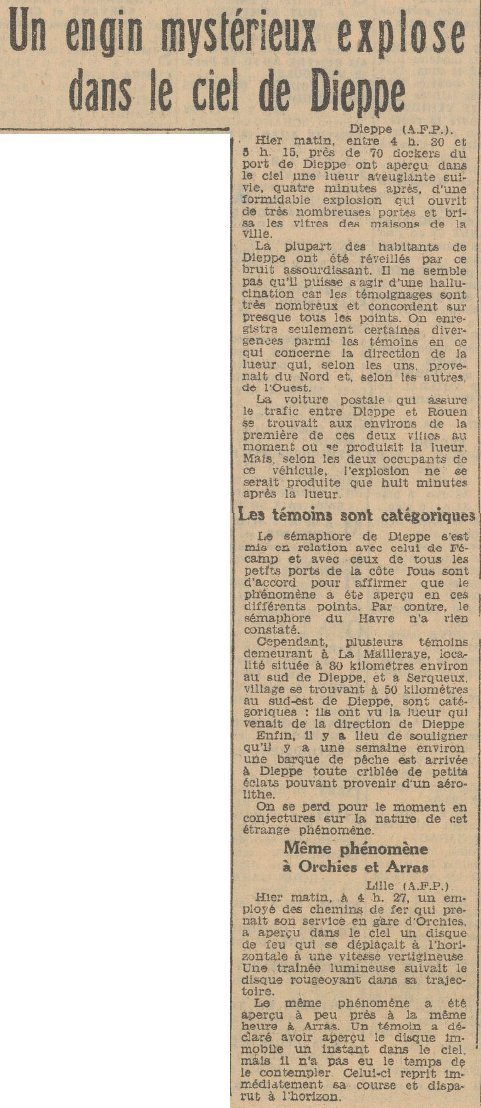
|
Dieppe (A.F.P.)
Yesterday morning, between 4:30 and 5:15 a.m., nearly 70 dockworkers at the port of Dieppe saw a blinding light in the sky, followed four minutes later by a tremendous explosion that blew open many doors and shattered windows throughout the town.
Most of the residents of Dieppe were awakened by the deafening noise. It does not appear to be a hallucination, as the testimonies are numerous and agree on almost every point. There is only some disagreement among witnesses regarding the direction of the light, which some say came from the north, and others from the west.
The postal van operating between Dieppe and Rouen was near the former at the time the light appeared. But according to the two occupants of the vehicle, the explosion occurred eight minutes after the light.
The Dieppe semaphore communicated with that of Fécamp and with those of all the small ports along the coast. All confirmed that the phenomenon was observed in these different locations. However, the semaphore at Le Havre reported no such event.
Meanwhile, several witnesses residing in La Mailleraye, a town about 80 kilometers south of Dieppe, and in Serqueux, about 50 kilometers southeast of Dieppe, were categorical: they saw the light coming from the direction of Dieppe.
It is also worth noting that about a week ago, a fishing boat arrived in Dieppe riddled with small fragments that could have come from a meteorite.
At the moment, the nature of this strange phenomenon remains a mystery.
Lille (A.F.P.)
Yesterday morning at 8:27 a.m., a railway employee starting his shift at Orchies station saw a fiery disc moving horizontally at breakneck speed. A glowing trail followed the red-hot disc as it moved across the sky.
The same phenomenon was seen at about the same time in Arras. One witness said they saw the disc hovering for a moment in the sky but did not have time to study it before it resumed its course and vanished over the horizon.
[Ref. bpc1:] NEWSPAPER "LE BIEN PUBLIC":

|
It is believed to be caused by the fall of a meteor
Dieppe, January 7. -- This morning, between 4:30 and 5:15 a.m., nearly 70 dockworkers from the port of Dieppe saw a blinding light in the sky, followed four minutes later by a tremendous explosion that blew open many doors and shattered several windows in houses throughout the city.
Most of the residents of Dieppe were awakened by the deafening noise. It does not appear
Continued on page 8

|
Continued from the front page
it is unlikely to have been a hallucination, as there are numerous testimonies that agree on almost every point. The only discrepancies among witnesses concern the direction of the light, which some said came from the north, while others claimed it came from the west.
The postal vehicle operating between Dieppe and Rouen was near the first of these two cities at the time the light appeared. However, according to the two occupants of the vehicle, the explosion occurred only eight minutes after the light.
The semaphore station in Dieppe contacted the one in Fécamp and those in all the small ports along the coast. All confirmed that the phenomenon was seen at these various locations. However, the semaphore station in Le Havre reported nothing.
Meanwhile, several witnesses living in La Mailleraye, a town about eighty kilometers southeast of Dieppe, and in Serqueux, a village located 50 kilometers southeast of Dieppe, were categorical: they saw the light coming from the direction of Dieppe.
Finally, it should be noted that about a week ago, a fishing boat arrived in Dieppe riddled with small fragments that could have come from a meteorite.
For the moment, the nature of this strange phenomenon remains the subject of speculation.
It is very likely, according to the Paris Astrophysics Institute, that the phenomenon observed this morning in the Dieppe area was a meteor. The very hour at which the sighting occurred - just before sunrise - supports this theory [!]. But, they added, such explosions are not very rare and have been recorded many times around the globe.
It is known that meteors are bodies whose origin and composition are poorly understood, and which move through the sky at extreme speeds, heating up when they encounter Earth's atmosphere due to the resistance it offers. That is when they become incandescent. Sometimes, they pass unnoticed except for a luminous trail. Sometimes, they explode silently, and sometimes with a loud bang. It also happens that they fall to Earth, whole or fragmented: such is the origin of meteorite falls.
[Ref. vmr1:] NEWSPAPER "VAR-MATIN - REPUBLIQUE":
It is said it is a bolide...
Dieppe, January 7. -- This morning, between 04:30 and 05:15, nearly 70 dockers of the Dieppe Harbor saw in the sky, a dazzling gleam followed four minutes later by a formidable explosion which opened numerous doors and broke several windows of the houses of the city.
Most of the Dieppe residents were awaked by this deafening noise. The Dieppe semaphore contacted that of Fécamp and with them, all the small harbours of the coast. All agree to state that the phenomenon was seen in these various points.
However, several witnesses in la Mailleraye, locality at 80 km approximately in the south of Dieppe, are categorical: they saw the gleam which came from the direction of Dieppe.
Lastly, it must be stressed that one week ago approximately, a small fishing boat arrived at Dieppe very sifted of small glares which might come from an aerolite.
This morning, at 04:27, a railroad worker which took his service in the railway station of Orchies, saw in the sky, a disc of fire which moved horizontally at a vertiginous speed. A luminous trail followed the reddish disc in its trajectory. The same phenomenon was seen about the same hour in Arras. A witness stated to have seen the disc motionless one moment in the sky.
But he did not have time to contemplate it as it resumed its race immediately and disappeared at the horizon.
A fireball
It is most likely, the Institute of Astrophysics of Paris estimates, certain that the observed phenomenon was nothing else than a bolide.
The very hour when this observation was made, little before the sunrise, contributes to support this opinion, are not rare and many others were recorded on all the surface of the globe.
It is known that the bolides are bodies whose origin and composition are little known about and who, moving in the sky at an extreme speed, warm up when they suddenly met the Earth's atmosphere because of the resistance that it opposes to them.
That is when they become incandescent. Sometimes, they pass without being reported differently than a luminous trail, sometimes with great noise. It also happens that they fall on the surface of the globe, entirely or fragmented. Such is the origin of aerolites falls.
[Ref. brn1:] NEWSPAPER "LE BERRY REPUBLICAIN":
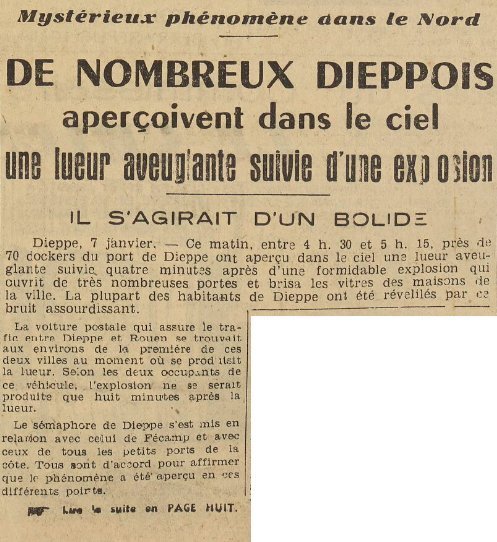
|
Dieppe, January 7. -- This morning, between 4:30 and 5:15 a.m., nearly 70 dockworkers from the port of Dieppe saw a blinding light in the sky followed four minutes later by a tremendous explosion that opened many doors and shattered the windows of houses throughout the city. Most of the inhabitants of Dieppe were awakened by the deafening noise.
The postal vehicle operating between Dieppe and Rouen was near the first of these two towns at the moment the light appeared. According to the two occupants of the vehicle, the explosion occurred only eight minutes after the flash.
The Dieppe semaphore made contact with the one in Fécamp and with those in all the small ports along the coast. All confirmed that the phenomenon was seen in each of these locations.
Read more on PAGE EIGHT
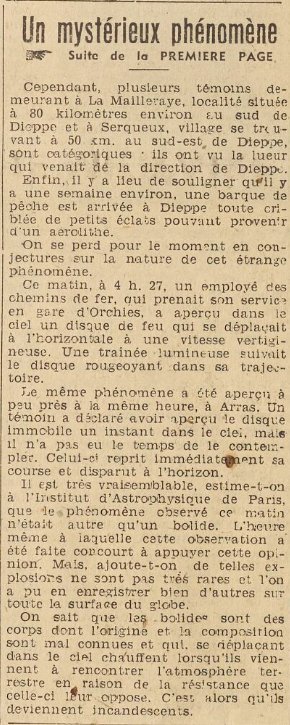
|
Continued from THE FRONT PAGE
However, several witnesses living in La Mailleraye, a locality located about 80 kilometers south of Dieppe, and in Serqueux, a village about 50 km southeast of Dieppe, are categorical: they saw the light, which came from the direction of Dieppe.
Finally, it is worth noting that about a week ago, a fishing boat arrived in Dieppe riddled with small fragments that could have come from a meteorite.
At the moment, speculation abounds regarding the nature of this strange phenomenon.
This morning at 4:27 a.m., a railway employee starting his shift at Orchies station saw in the sky a disc of fire moving horizontally at dizzying speed. A luminous trail followed the glowing disc along its path.
The same phenomenon was seen at roughly the same time in Arras. A witness stated that he saw the disc standing still for a moment in the sky, but did not have time to observe it further. It immediately resumed its course and disappeared over the horizon.
It is very likely, according to the Paris Institute of Astrophysics, that the phenomenon observed this morning was nothing other than a fireball. The very time at which the observation was made supports this opinion. But, they add, such explosions are not very rare and have been recorded many times all over the globe.
It is known that fireballs are bodies whose origin and composition are poorly understood, and which, when moving through the sky, heat up as they encounter the Earth's atmosphere due to the resistance it exerts. It is then that they become incandescent.
[Ref. ppe1:] NEWSPAPER "PARIS-PRESSE":
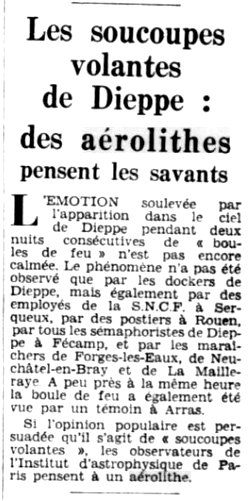
|
THE EMOTION raised by the appearance in the sky of Dieppe during two following nights of "balls of fire" is not yet quiet down. The phenomenon was not only observed by the dockers of Dieppe, but also by S.N.C.F. employees in Serqueux, by postmen in Rouen, by all the semaphore operators of Dieppe to Fécamp, and by the market gardeners of Forges-les-Eaux, Neuchâtel-en-Bray and of La Mailleraye. At about the same hour the ball of fire was also seen by a witness in Arras.
While popular opinion is convinced that these are "flying saucers", observers from the Paris Astrophysical Institute think of a fireball.
[Ref. aml1:] AIME MICHEL:
Aimé Michel indicates that on January 7, 1954, a few seconds after 04:27 a.m., all the department of Seine-Inférieur, from Fécamp in the west up to Dieppe in the north, from la Mailleraye in the south to Gournay in the East, was illuminated by a general flashover of the sky. During one half-minute, the light was so intense that the railwaymen of Serqueux could read the serial numbers of the coaches.
A few minutes later, Dieppe was shaken by a gigantic explosion which broke many windows and woke up from their sleep three quarters of the city.
Aimé Michel notes that after the observations of that day, in the evening, a spokesman of the Institute of astrophysics of Paris sais it was very likely a meteor. Aimé Michel comments:
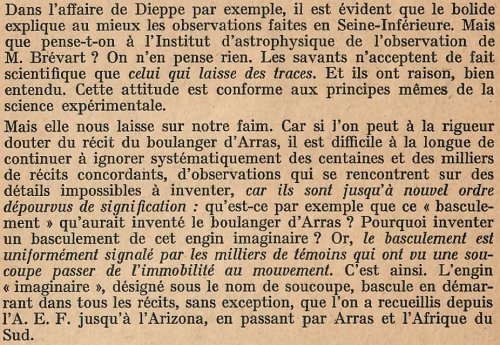
|
In the Dieppe affair for example, it is obvious that the fireball best explains the observations made in Seine-Inférieure. But what does the Institute of Astrophysics think of the observation of Mr. Brévart? They don't think anything of it. Scientists accept scientific fact only those who leave traces. And they are right, of course. This attitude is consistent with the very principles of experimental science.
But it leaves us frustrated. Because if we can possibly doubt the story of the Arras baker [Brévart], it is difficult in the long run to continue to systematically ignore hundreds and thousands of concordant stories, observations that meet on details impossible to invent, because they are meaningless until further notice: what, for example, is this "rocking" invented by the baker from Arras? Why invent a tilting of this imaginary craft? However, the riôcking is uniformly indicated by the thousands of witnesses who saw a saucer go from stillness to movement. This is how it is. The "imaginary" object, designated under the name of saucer, tilts when departing in all the stories, without exception, that have been collected since the A. E. F. [French Central Africa] to Arizona, via Arras and South Africa.
[Ref. rct1:] ROBERT CATINAT:

|
The luminous phenomenon [of Dieppe on January 7, 1954] was seen in Fécamp and in many small ports on the coast, but one did not see anything in Le Havre. At La Mailleraye (80 km S of Dieppe) and in Serqueux (50 km S of Dieppe) one saw the light that came from the direction of this city.
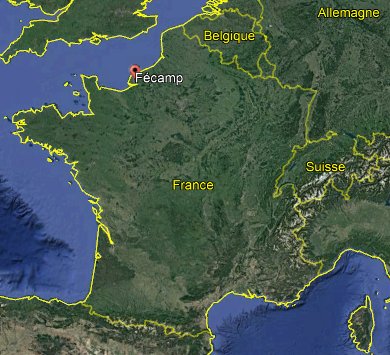
|
The meteor of January 7, 1954.
(These keywords are only to help queries and are not implying anything.)
Fécamp, Seine-Maritime, meteor, ball, fire, semaphore
[----] indicates sources that are not yet available to me.
| Version: | Created/Changed by: | Date: | Change Description: |
|---|---|---|---|
| 1.0 | Patrick Gross | January 12, 2020 | First published. |
| 1.1 | Patrick Gross | January 18, 2020 | Addition [rct1]. |
| 1.2 | Patrick Gross | May 2, 2025 | Addition [bpc1]. |
| 1.3 | Patrick Gross | June 28, 2025 | Addition [brn1]. |